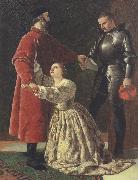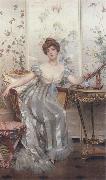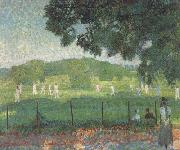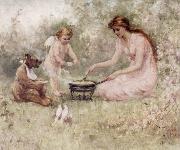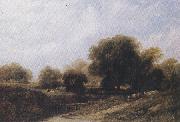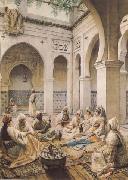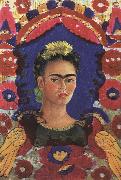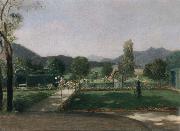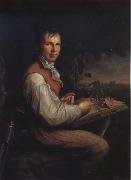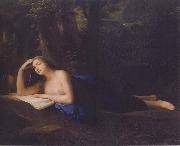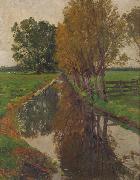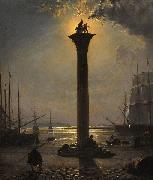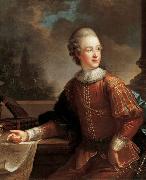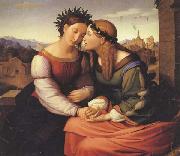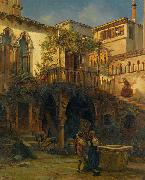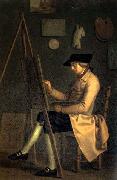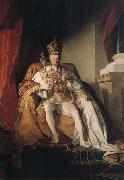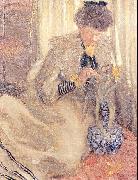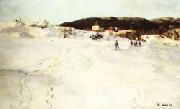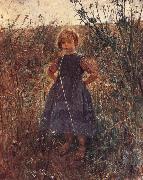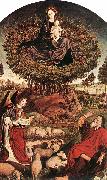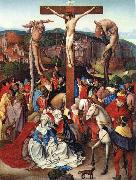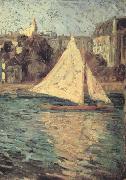|
|
|
|
|
|
|
|
|
|
|
|
|
|
|
|
 |
Frederick William Woodhouse
|
|
Frederick William Woodhouse
1820-1909
Woodhouse was born in Britain, but is better known as an Australian artist after his move to Australia. He painted images of Bush Life, and made many images from direct observation in sketchbooks and watercolors. He was also Australiaes most important horse racing painter, having painted every Melbourne Cup winner from 1861 until the introduction of the trackside camera. Although horses were his mainstay, Woodhouse also painted dogs, sheep, cattle, landscapes and portraits of persons. Between 1893 and 1894 he made a number of landscapes during a trip to Tasmania. |
|
|
|
 |
Frederik de Moucheron
|
|
(1633-2 January 1686) was a Dutch Golden Age landscape painter.
Frederik de Moucheron was the son of the painter Balthazar de Moucheron and Cornelia van Brouckhoven. His father came from a wealthy family of wine traders and is portrayed as one of the younger sons in the Moucheron Family portrait, 1563. Frederik trained with Jan Asselijn and became a landscape painter. He set off at age 22 for Paris, where he spent 3 years and then after a tour of Antwerp, Paris. and Lyon, he settled in 1659 in Amsterdam. In the same year he married Mariecke de Jouderville there and they had 11 children. He is buried in Amsterdam.
He painted French, Italian, and Dutch landscapes. To finish these scenes, contemporaries specialized in painting figures collaborated with him, such as Adriaen van de Velde in Amsterdam, Theodor Helmbreker in Paris, and at times Johannes Lingelbach, and Nicolaes Pieterszoon Berchem.
|
|
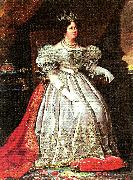 |
fredrik westin
|
|
Fredric Westin, född den 22 september 1782 i Stockholm, död 13 maj 1862 i Stockholm, historie- och porträttmålare.
Westin hade varit elev hos Lorens Pasch d.y. och Louis Masreliez på Konstakademien. Sedan han 1808 blivit kallad till akademiens agr?? och förordnad till konduktör vid kungliga museet blev han 1812 invald i Konstakademiens styrelse. Han blev 1815 vice professor och 1816 professor vid Konstakademien. Där var han också 1828-1840 direktör. 1843 utnämndes han till hovintendent.
Till hans tidigare skede och till hans främsta alster hör "Dagens stunder", fyra dörrstycken i Karl Johans sängkammare på Rosersbergs slott med antikiserande figurer: Aurora som strör blommor över jorden, Apollon med sitt fyrspann, Diana följd av Aftonrodnaden samt Natten med sitt stjärnströdda dok (1812-13). På Säfstaholms slott finns "De fyra årstiderna presiderade av jordens gudinna" (1843), på Rosendals slott "Hebe med örnen" (1832) och "Flora bekransande Linn??s byst" (1843) och vid Stockholms universitet "Musiken, föreställd av en grupp unga flickor". Han målade också kompositioner ur den svenska historien ("Olof Skötkonungs dop", "Lutherska lärans antagande").
Westin målade en stor mängd porträtt då han under Karl XIV Johans tid var konstnären på modet. Som porträttmålare var han dock inte enhälligt uppskattad. En kritiker som Silverstolpe beklagade 1809 att en konstnär som "äger så mycken färdighet till stöd för sitt sökande av idealet" sysselsatte sig med en konst av så lågt värde och hoppades att han "måtte återvända från den platta verkliga världen till den poetiska." Hammarsköld menade 1818 att av de svenska konstnärerna var det Westin som hade de ringaste anlagen för porträttmålning. Scholander kallade hans porträtt för "vaxgubbar". Andra hade lovord att fälla över Westins porträtt. Gerss ansåg att Westins porträtt hade likhet och behag i uttrycket, enkelhet i ställning och klädsel, urval av natur i formerna och säkerhet och sanning i utförandet. Wennberg kallade honom "den förste svenske tecknarens Lorenz Paschs så värdige fosterson".
Under Karl XIV Johans tid målade han rad porträtt på kungafamiljen. 1824 målade han en populär allegori över kronprinsessan Josefinas ankomst till Sverige, där Saga i gul och blå dräkt sitter på marken framför en runsten och blickar upp mot skyn där kronprinsessan i röd och vit dräkt svävar ned på en molntapp omgiven av tre amoriner. 1838 målade han Karl XIV Johan till häst på Ladugårdsgärdet hälsande med den trekantiga hatten.
Efter att Sandbergs altartavla för Sankt Jacobs kyrka hade underkänts vände sig de ansvariga till Westin med uppdraget att måla en altartavla. Målningen, "Kristi förklaring" var klar 1828 och resultatet blev både hyllat och kritiserat. Andra altartavlor av Westin finns i Kungsholms kyrka ("Kristi uppståndelse", 1825), Åbo domkyrka ("Kristi förklaring", 1836), Uddevalla kyrka ("Kristus välsignar barnen") samt Carl Gustafs kyrka ("Kristi begravning", 1832). |
|
|
|
|
|
|
|
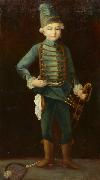 |
Friedrich August von Kaulbach
|
|
(2 June 1850, Hannover - 26 July 1920, Munich, Germany) was a German portraitist and historical painter. He was the son of Theodor Friedrich Wilhelm Christian Kaulbach (1822 - 1903), the court painter at Hannover, and the great nephew of Wilhelm Kaulbach, another prominent member of the Kaulbach family of artists. He learned to paint from his father, and later was a student of August von Kreling at Nuremberg. He sought to emulate the artist Hans Holbein. |
|
 |
Friedrich Carl Groger
|
|
(14 October 1766, Plön - 9 November 1838, Hamburg) was a north-German portrait painter and lithographer. One of the most respected portraitists of his time in northern Germany, his works are to be found in several museums, including the Hamburger Kunsthalle, as well as in north German, Holstein and Danish private collections.
Gröger was the son of a tailor in Plön, where he grew up in modest circumstances. His parents wanted him to become a tailor or wood turner and opposed his early artistic activities. He was largely self taught in painting, though he had some contact in Lebeck with Tischbein and in 1785 was in the city of Lebeck, where he met Heinrich Jacob Aldenrath, his first, loyalest and lifelong friend - the Grögersweg in Hamburg-Barmbek named after him links the Tischbeinstraße with the Aldenrathsweg.
From 1789 he studied at Berlin's Akademie der Kenste. He and Aldenrath then went together to Hamburg, then on a joint study trip to Dresden and Paris, then back to Lebeck, where he worked until 1807. They then alternated between Hamburg, Copenhagen, Kiel and Lebeck, before finally settling in Hamburg in 1814. In 1792 Gröger was made an honorary member of the Gesellschaft zur Beförderung gemeinnetziger Tätigkeit in Lebeck.
Gröger developed from a miniature painter into a portrait painter, who towards the end of his life preferred three quarter bust portraits. Aldenrath took over the miniature painting side of their joint business. After lithography developed in northern Germany, they both worked in this medium individually as well as jointly under the business name Firma Gröger & Aldenrath.
|
|
|
|
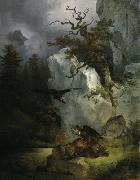 |
Friedrich Gauermann
|
|
(September 10, 1807 - July 7, 1862), Austrian painter, son of the landscape painter Jacob Gauermann (1773 - 1843), was born at Miesenbach near Gutenstein in Lower Austria.
It was the intention of his father that he should devote himself to agriculture, but the example of an elder brother, who, however, died early, fostered his inclination towards art. Under his father's direction he began studies in landscape, and he also diligently copied the works of the chief masters in animal painting which were contained in the academy and court library of Vienna. In the summer he made art tours in the districts of Styria, Tirol, and Salzburg.
Two animal pieces which he exhibited at the Vienna Exhibition of 1824 were regarded as remarkable productions for his years, and led to his receiving commissions in 1825 and 1826 from Prince Metternich and Caraman, the French ambassador. His reputation was greatly increased by his picture "The Storm," exhibited in 1829, and from that time his works were much sought after and obtained correspondingly high prices. His "Field Labourer" was regarded by many as the most noteworthy picture in the Vienna exhibition of 1834, and his numerous animal pieces have entitled him to a place in the first rank of painters of that class of subjects.
The peculiarity of his pictures is the representation of human and animal figures in connexion with appropriate landscapes and in characteristic situations so as to manifest nature as a living whole, and he particularly excels in depicting the free life of animals in wild mountain scenery. Along with great mastery of the technicalities of his art, his works exhibit patient and keen observation, free and correct handling of details, and bold and clear colouring. He died at Vienna on the 7th of July 1862.
Many of his pictures have been engraved, and after his death a selection of fifty-three of his works was prepared for this purpose by the Austrian Kunstverein (Art Union).
|
|
|
|
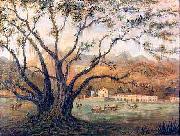 |
Friedrich Hagedorn
|
|
(23 April 1708 - 28 October 1754), German poet, was born at Hamburg, where his father, a man of scientific and literary taste, was Danish minister.
He was educated at the gymnasium of Hamburg, and later (1726) became a student of law at Jena. Returning to Hamburg in 1729, he obtained the appointment of unpaid private secretary to the Danish ambassador in London, where he lived till 1731. Hagedorn's return to Hamburg was followed by a period of great poverty and hardship, but in 1733 he was appointed secretary to the so-called "English Court" (Englischer Hof) in Hamburg, a trading company founded in the 13th century. He shortly afterwards married, and from this time had sufficient leisure to pursue his literary occupations till his death.
Hagedorn is the first German poet who bears unmistakable testimony to the nation's recovery from the devastation wrought by the Thirty Years' War. He is eminently a social poet. His light and graceful love-songs and anacreontics, with their undisguised joie de vivre, introduced a new note into the German lyric; his fables and tales in verse are hardly inferior in form and in delicate persiflage to those of his master La Fontaine, and his moralizing poetry re-echoes the philosophy of Horace. He exerted a dominant influence on the German lyric until late in the 18th century.
The first collection of Hagedorn's poems was published at Hamburg shortly after his return from Jena in 1729, under the title Versuch einiger Gedichte (reprinted by A. Sauer, Heilbronn, 1883). In 1738 appeared Versuch in poetischen Fabeln und Erzählungen; in 1742 a collection of his lyric poems, under the title Sammlung neuer Oden und Lieder; and his Moralische Gedichte in 1750. A collection of his entire works was published at Hamburg in 1757 after his death. The best is J.J. Eschenburg's edition (5 vols., Hamburg, 1800). Selections of his poetry with an excellent introduction in F. Muncker's Anakreontiker und preussisch-patriotische Lyriker (Stuttgart, 1894). See also H. Schuster, F. von Hagedorn und seine Bedeutung fer die deutsche Literatur (Leipzig, 1882); W. Eigenbrodt, Hagedorn und die Erzählung in Reimversen (Berlin, 1884).
|
|
|
|
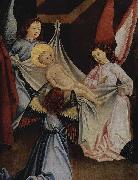 |
Friedrich Herlin
|
|
(c. 1425/30 - 1500) was a German painter. His earliest known work, depicting scenes from the Life of the Virgin, is dated 1459. A signature on an altarpiece in Nördlingen, dating it to 1462, identifies him as being from Rothenburg, as do citizenship documents from 1467. Nevertheless, it is possible that he lived there for only a short time, and that his origins lie in Ulm, where a painter named Hans Herlin lived and worked from 1449 until 1468. Stylistically, he borrowed much from Rogier van der Weyden, indicating a great deal of familiarity with the art of the Netherlands and of Cologne. The sculpture attached to the altarpiece of 1462, though officially listed as by the so-called "Master of Nördlingen", has been tentatively ascribed to Nicolaus Gerhaert, which if true would indicate extensive contacts to the highest artistic circles of the era.
Little else is known of Herlin, save that he died in Nördlingen in 1500.
|
|
|
|
|
|
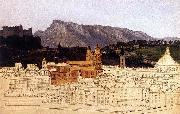 |
Friedrich Loos
|
|
was an Austrian Biedermeier style painter, etcher and lithographer. He was born in Graz on 29 October 1797. He studied at the Vienna Academy with Joseph Mössmer and also went on study tours through the Austrian Alpine regions. From 1835 to 1836 he lived in Vienna, and as of 1846 he sojourned in Rome. He then moved to Kiel, where he worked as a drawing teacher at the university as of 1863 and where he also died on 9 May 1890. In his pictures he emphasized light and color in order to loosen up his painting, as well as to harmonize and unite the details.
|
|
|
|
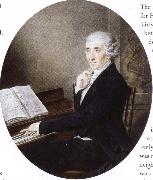 |
friedrich nietzsche
|
|
Period: Romantic (1820-1869)
Country: Germany
Born: October 15, 1844 in Röcken
Died: August 25, 1900 in Weimar |
|
|
|
|
|
|
|
|
|
|
|
|
|
|
|
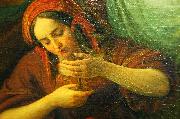 |
Friedrich Wilhelm Schadow
|
|
Friedrich Wilhelm Schadow (7 September 1789 - 19 March 1862) was a German Romantic painter.
He was born in Berlin and was the second son of the sculptor Johann Gottfried Schadow.
In 1806-1807 Friedrich served as a soldier. In 1810 he traveled with his elder brother Rudolph to Rome where he became one of the leaders among painters of the Nazarene movement. Following the example of Johann Friedrich Overbeck and others, he joined the Roman Catholic Church, and held that an artist must believe and live out the truths he essays to paint. The sequel showed that Schadow was qualified to shine more as a teacher and mentor than as a painter. As an author, he is best known for his lecture, Ueber den Einfluss des Christentums auf die bildende Kunst (About The Influence of Christianity On The Visual Arts) (Desseldorf, 1843), and the biographical sketches, Der moderne Vasari (Berlin, 1854).
In Rome, Schadow was given one of his first major commissions when the Prussian Consul-General, General Jakob Salomon Bartholdy, befriended the young painter, and asked him and three young compatriots (Cornelius, Overbeck and Veit) to decorate in fresco a room in his house on the Pincian Hill. The overall theme selected was the story of Joseph and his brethren, and two scenes, the Bloody Coat and Joseph in Prison, were conferred on Schadow. In 1819, Schadow was appointed professor in the prestigious Berlin Academy of the Arts, and his ability and thorough training gained many devoted disciples.
It was during this period that Schadow developed his paintings for churches. In 1826, Professor Schadow was made director of the Desseldorf Academy of the Arts, which he reoriented towards the production of Christian art, though he began a major dispute with one of its professors, Heinrich Christoph Kolbe, ending in the latter leaving the Academy in 1832. In 1837, Schadow selected, at request, those of his students best qualified to decorate the chapel of St Apollinaris on the Rhine with frescoes. When finished, they were acclaimed as the fullest and purest manifestation of the spiritual side of the Desseldorf school. One of his famous students, Heinrich Mucke, carried on the liturgical art with emphasis both in painting and frescoes. The painting of the "Wise and Foolish Virgins," considered one of his masterworks, was commissioned in 1842. Now in the Städel Museum, this large and important picture, while carefully considered and rendered, it however lacks power of some of his other works. |
|
|
|
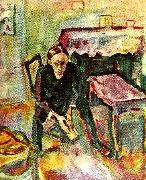 |
friesz
|
|
Achille-Emile Othon Friesz who later called himself just Othon Friesz (6 February 1879 - 10 January 1949), a native of Le Havre, was a French artist of the Fauvist movement. |
|
|
|
|
|
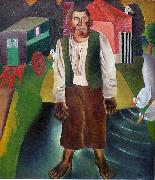 |
Frits Van den Berghe
|
|
(3 April 1883 - 22 September 1939) was a Belgian expressionist painter.
He was born at Ghent. Like his friends Constant Permeke and Gustave De Smet, he first adopted the late-impressionist style of Emile Claus, but converted to expressionism during World War I.
|
|
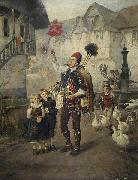 |
Fritz Beinke
|
|
(1842- 1907 ) - Painter
painted The toymaker of Nuremberg in 1882 |
|
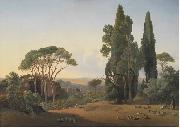 |
Fritz Petzholdt
|
|
(1 January 1805 - 29 August 1838) was a Danish landscape painter of the Copenhagen School, also known as the Golden Age of Danish Painting. He spent most of his artistic life in Italy, where he painted refined landscapes in a light colour palette but died early, most likely by way of suicide.
Fritz Petzholdt was born into a prosperous home on 1 January 1805 in Copenhagen to grocer Johan Jacob Petzholdt and his second wife Josephine Marie Elisabeth Petzholdt. After completing an apprenticeship as a house painter, he attended the Royal Danish Academy of Fine Arts from 1824 where he studied under Christoffer Wilhelm Eckersberg, known as the farther of the Golden Age of Danish Painting spanning the first half of the 19th century. He graduated in 1828 and already the following year sold a painting, En mose ved Høsterkøb med tørvearbejdere (A Bog at Høsterkøb), to the Royal Danish Painting Collection.
Although he never won the Academy's gold medal, the traditional opening for Academy students to go abroad to further their studies since it was accompanied by a travel stipend, his family's wealth allowed him to travel to Harz the same year and then, in May 1830, to set out for Rome. On the way he visited Dresden, Prague, Nuremberg, Munich, Venice and Florence. In Rome he joined the Danish artists colony which had formed in the city with Bertel Thorvaldsen as its centre. He made excursions to the Roman countrysideeto places such as Tivoli, Subiaco and Olevanoeas well as longer trips south to Naples, Sicily and Corfu.
In the winter of 1835/36 he returned to Copenhagen due to his farther's illness and subsequent death. Shortly after the funeral, he returned to Italy with an extended stop in Munich on the way. From Italy he continued to Greece, a destination only Martinus Rørbye had visited before him among the Danish Golden Age painters. On 29 August 1838 he was found dead in his hotel room in Patras with his throat cut. Whether it was a case of suicide or murder was never settled.
|
|
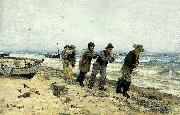 |
fritz thaulow
|
|
född 1847 i Christiania, död 5 november 1906, var en norsk målare. Han är en av de internationellt mest kända norska konstnärerna från 1800-talet.
Thaulow fick sin utbildning vid Konstakademin i Köpenhamn 1870 -72, och 1873-75 var han elev till Hans Gude i Karlsruhe. Åren efter detta uppehöll han sig för det mesta i Paris där han fick avgörande intryck från de franska impressionisterna.
1880 vände Thaulow hem som överbevisad naturalist. Tillsammans med Christian Krohg och Erik Werenskiold blev han snabbt en av ledarna i de unge konstnärernas kamp för en rikare och mer vidsynt norsk konstmiljö. Thaulow var bl.a. med på att etablera den första Höstutställningen 1882.
1892 slog han sig ner i Frankrike, och han besökte USA 1898. Från och med samma år bosatte han sig i Paris, där han blev en kändis och blev också känd internationellt, bl.a. genom att bli antagen till den prestigefulla Salongen. |
|
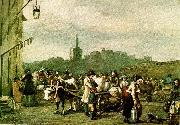 |
fritz von dardel
|
|
Fritz Ludvig von Dardel, född den 24 mars 1817 i Neuchâtel, död den 27 maj 1901 i Stockholm, var en schweiziskfödd svensk överintendent, militär, målare och tecknare.
Fritz von Dardel var son till godsägaren Georges-Alexandre von Dardel och grevinnan Hedvig Sofia Charlotta Amalia Lewenhaupt. Han var gift med friherrinnan Augusta Silfverschiöld. Släkten von Dardel kommer från Schweiz och adlades i Sverige 1810.
Von Dardel blev vid sexton års ålder konstapelkadett vid Vendes artilleriregemente, 1837 underlöjtnant vid Svea livgarde och avancerade till överstelöjtnant i armen 1862. Han blev 1850 adjutant hos kronprinsen och sedan hos Karl XV. Von Dardel var 1858-62 militärattach?? i Paris samt blev 1864 kabinettskammarherre hos Karl XV och samma år överintendent och ordföranden i Akademin för de fria konsterna, av vilken han 1861 invalts till hedersledamot. Dessutom var han ordförande i Nationalmuseums nämnd i 25 år (1867-92).
Vid flera konstutställningar i Europa (1867, 1871, 1873 och 1878) samt i Philadelphia (1876) var han juryman.
Själv hade von Dardel bedrivit studier på L??on Cogniets och E. Lamis ateljeer i Paris.
Fritz von Dardel tillhörde Karl XV:s intima krets och har gjort ett flertal dråpliga, akvarellerade teckningar av personer och händelser vid hovet eller under kungens resor, vidare folklivsbilder samt litografier. Hans dagböcker (se nedan) som utgavs postumt är skrivna på franska och översatta och redigerade av hans söner. |
|
|
|
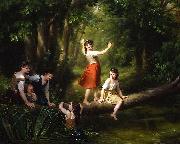 |
Fritz Zuber-Buhler
|
|
was a Swiss painter integrant of the style Academic Classicism, born in 1822 at Le Locle in Switzerland and died November 23, 1896.
At sixteen years old he moved to Paris, France where found his first teacher Louis Grosclaude. Later he studied at the École des Beaux-Arts and then refined his technical skills with François-Édouard Picot, who followed the same lineage of contemporaneous artists such as Leon Perrault, Bouguereau, Alexandre Cabanel and many others. Afterwards he spent some time in Italy searching for inspiration and raise the quality of his art. Then, returning to Paris, he made his debut at the Salon in 1850 exhibiting alongside oil paintings, drawings, pastels and watercolors.
His painting Innocence shows his romantic view of the peasant childhood and their environments, expressing nature, softness and intense details. Also his works were drawn by popular themes at that period like mythology, religion and requested portraits. Zuber-Buhler produced exhibitions in the United States, comprising at the Pennsylvania Academy of the Fine Arts and achieved great admiration as a classic academic painter. |
|
|
|
|
|
|
|
|
|
|







